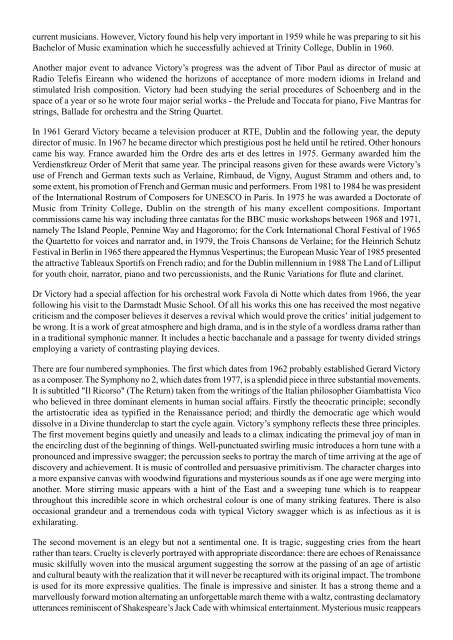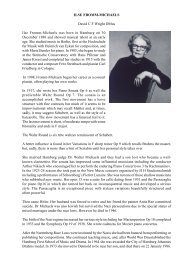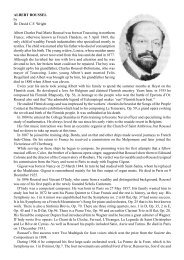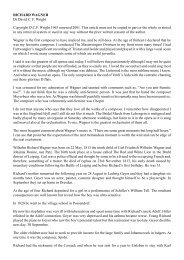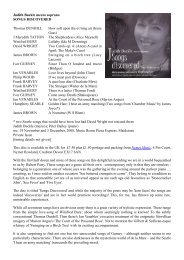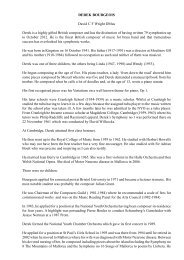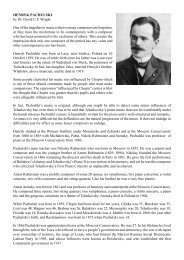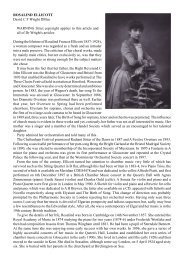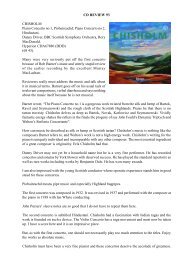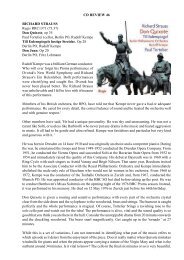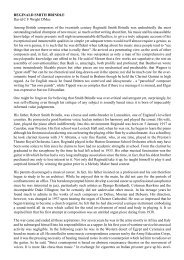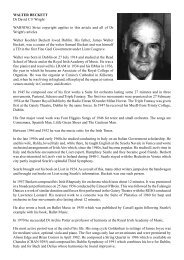Create successful ePaper yourself
Turn your PDF publications into a flip-book with our unique Google optimized e-Paper software.
current musicians. However, <strong>Victory</strong> found his help very important in 1959 while he was preparing to sit his<br />
Bachelor of Music examination which he successfully achieved at Trinity College, Dublin in 1960.<br />
Another major event to advance <strong>Victory</strong>’s progress was the advent of Tibor Paul as director of music at<br />
Radio Telefis Eireann who widened the horizons of acceptance of more modern idioms in Ireland and<br />
stimulated Irish composition. <strong>Victory</strong> had been studying the serial procedures of Schoenberg and in the<br />
space of a year or so he wrote four major serial works - the Prelude and Toccata for piano, Five Mantras for<br />
strings, Ballade for orchestra and the String Quartet.<br />
In 1961 <strong>Gerard</strong> <strong>Victory</strong> became a television producer at RTE, Dublin and the following year, the deputy<br />
director of music. In 1967 he became director which prestigious post he held until he retired. Other honours<br />
came his way. France awarded him the Ordre des arts et des lettres in 1975. Germany awarded him the<br />
Verdienstkreuz Order of Merit that same year. The principal reasons given for these awards were <strong>Victory</strong>’s<br />
use of French and German texts such as Verlaine, Rimbaud, de Vigny, August Stramm and others and, to<br />
some extent, his promotion of French and German music and performers. From 1981 to 1984 he was president<br />
of the International Rostrum of Composers for UNESCO in Paris. In 1975 he was awarded a Doctorate of<br />
Music from Trinity College, Dublin on the strength of his many excellent compositions. Important<br />
commissions came his way including three cantatas for the BBC music workshops between 1968 and 1971,<br />
namely The Island People, Pennine Way and Hagoromo; for the Cork International Choral Festival of 1965<br />
the Quartetto for voices and narrator and, in 1979, the Trois Chansons de Verlaine; for the Heinrich Schutz<br />
Festival in Berlin in 1965 there appeared the Hymnus Vespertinus; the European Music Year of 1985 presented<br />
the attractive Tableaux Sportifs on French radio; and for the Dublin millennium in 1988 The Land of Lilliput<br />
for youth choir, narrator, piano and two percussionists, and the Runic Variations for flute and clarinet.<br />
<strong>Dr</strong> <strong>Victory</strong> had a special affection for his orchestral work Favola di Notte which dates from 1966, the year<br />
following his visit to the Darmstadt Music School. Of all his works this one has received the most negative<br />
criticism and the composer believes it deserves a revival which would prove the critics’ initial judgement to<br />
be wrong. It is a work of great atmosphere and high drama, and is in the style of a wordless drama rather than<br />
in a traditional symphonic manner. It includes a hectic bacchanale and a passage for twenty divided strings<br />
employing a variety of contrasting playing devices.<br />
There are four numbered symphonies. The first which dates from 1962 probably established <strong>Gerard</strong> <strong>Victory</strong><br />
as a composer. The Symphony no 2, which dates from 1977, is a splendid piece in three substantial movements.<br />
It is subtitled "Il Ricorso" (The Return) taken from the writings of the Italian philosopher Giambattista Vico<br />
who believed in three dominant elements in human social affairs. Firstly the theocratic principle; secondly<br />
the artistocratic idea as typified in the Renaissance period; and thirdly the democratic age which would<br />
dissolve in a Divine thunderclap to start the cycle again. <strong>Victory</strong>’s symphony reflects these three principles.<br />
The first movement begins quietly and uneasily and leads to a climax indicating the primeval joy of man in<br />
the encircling dust of the beginning of things. Well-punctuated swirling music introduces a horn tune with a<br />
pronounced and impressive swagger; the percussion seeks to portray the march of time arriving at the age of<br />
discovery and achievement. It is music of controlled and persuasive primitivism. The character charges into<br />
a more expansive canvas with woodwind figurations and mysterious sounds as if one age were merging into<br />
another. More stirring music appears with a hint of the East and a sweeping tune which is to reappear<br />
throughout this incredible score in which orchestral colour is one of many striking features. There is also<br />
occasional grandeur and a tremendous coda with typical <strong>Victory</strong> swagger which is as infectious as it is<br />
exhilarating.<br />
The second movement is an elegy but not a sentimental one. It is tragic, suggesting cries from the heart<br />
rather than tears. Cruelty is cleverly portrayed with appropriate discordance: there are echoes of Renaissance<br />
music skilfully woven into the musical argument suggesting the sorrow at the passing of an age of artistic<br />
and cultural beauty with the realization that it will never be recaptured with its original impact. The trombone<br />
is used for its more expressive qualities. The finale is impressive and sinister. It has a strong theme and a<br />
marvellously forward motion alternating an unforgettable march theme with a waltz, contrasting declamatory<br />
utterances reminiscent of Shakespeare’s Jack Cade with whimsical entertainment. Mysterious music reappears


